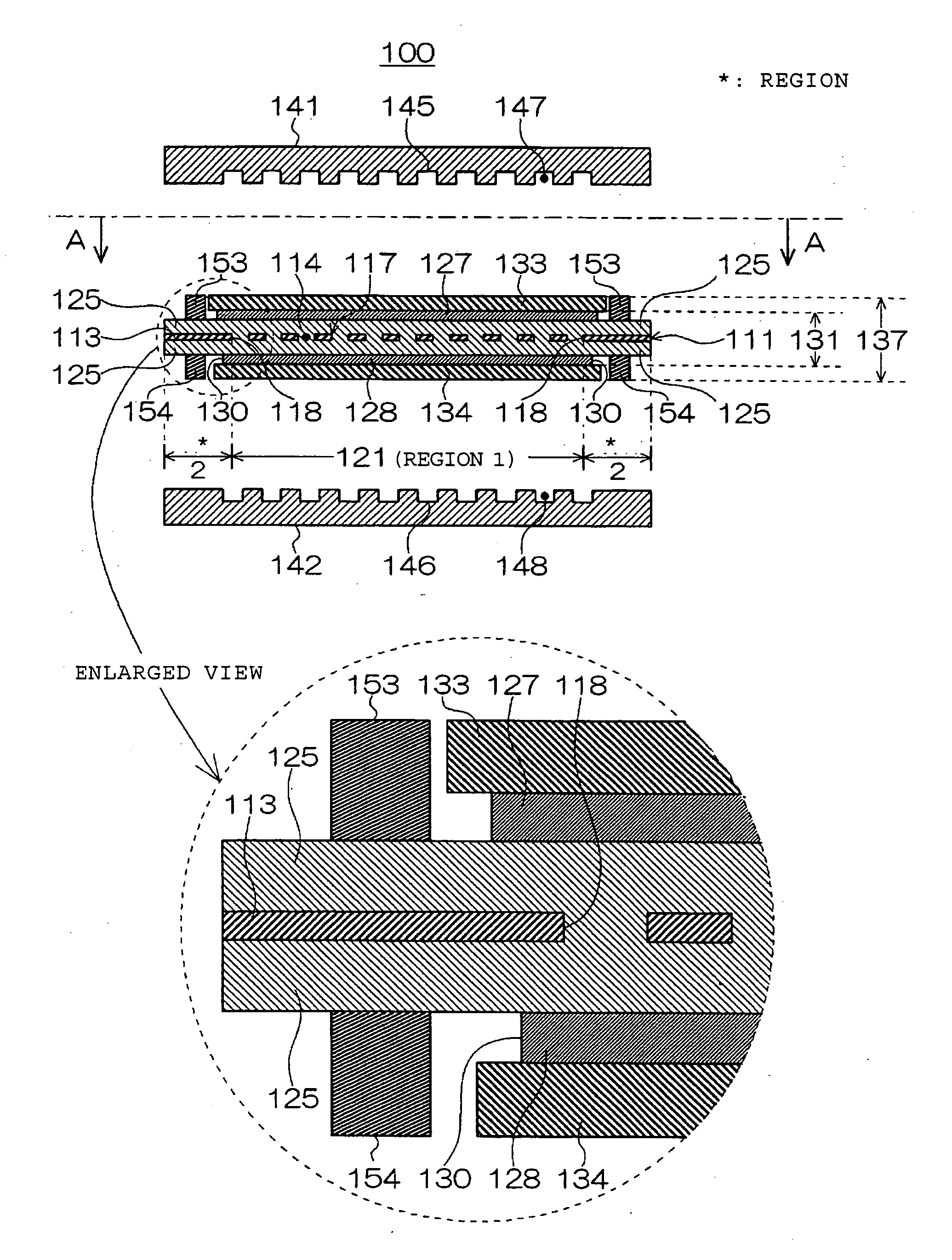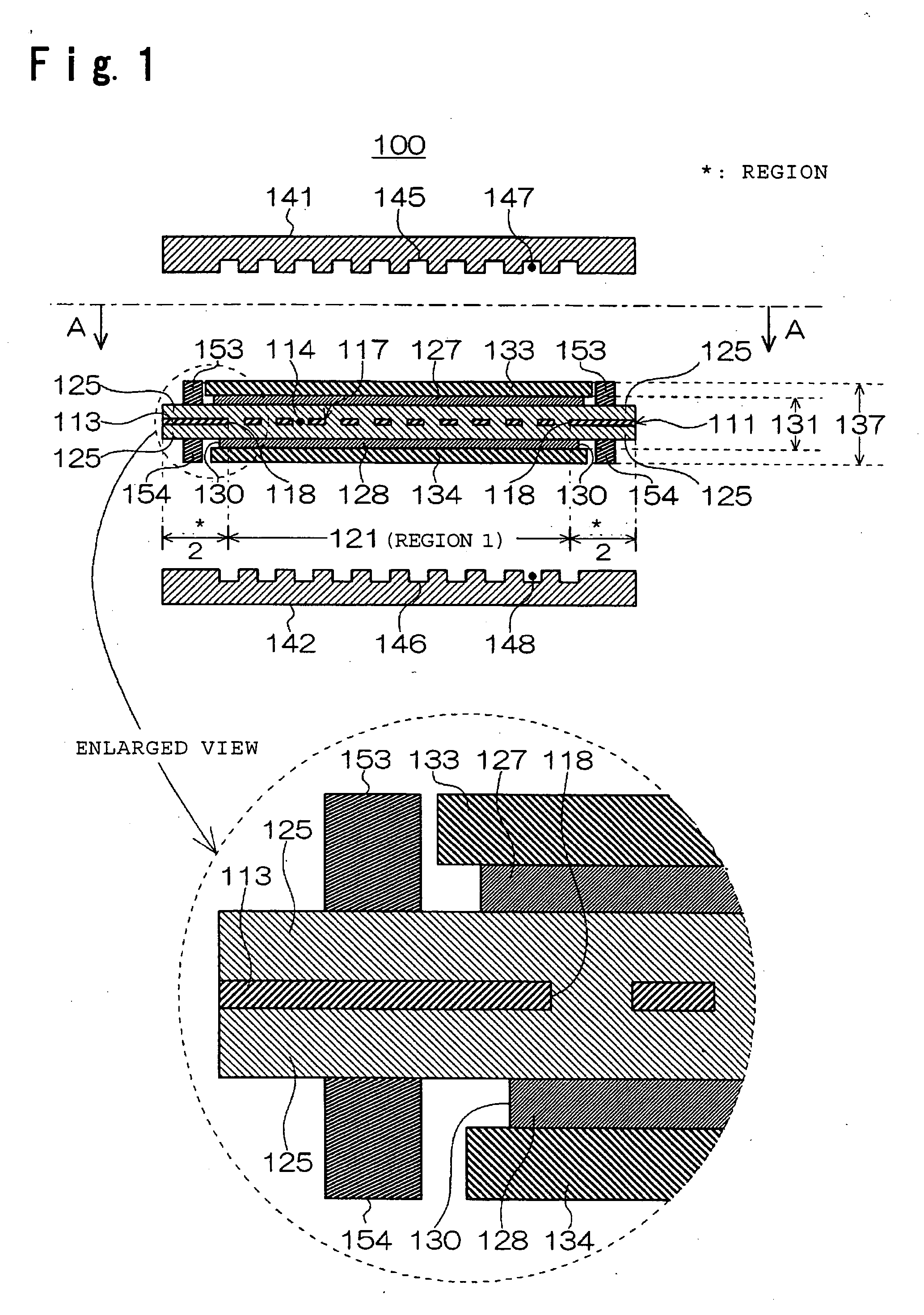Membrane-electrode assembly for polymer electrolyte fuel cells, and polymer electrolyte fuel cell
a technology of electrolyte fuel cells and membrane electrodes, which is applied in the direction of cell components, cell component details, electrochemical generators, etc., can solve the problems of insufficient proton conductivity in the vicinity of its center, deterioration of the polymer electrolyte membrane or short circuiting of the electrodes, and damage to the membrane in the vicinity of the end portions of the electrode catalyst layer, etc., to prevent the deterioration of the polymer electrolyte membran
- Summary
- Abstract
- Description
- Claims
- Application Information
AI Technical Summary
Benefits of technology
Problems solved by technology
Method used
Image
Examples
example 1
Preparation of Membrane
[0172] At a principal center portion of a polyphenylene sulfide film (tradename: Torelina 3030-12, manufactured by Toray Industries, Inc.) of a 200 mm square having a thickness of 12 μm, 213,280 through-holes having a diameter of 300 μm (average area per through-hole: about 0.071 mm2) were formed in a staggered arrangement so as to have a center distance of 350 μm by multiple spindle drilling, to prepare a perforated sheet 113 having a region 1 of a 150 mm square having an open area ratio of is about 67% and a region 2 having no apertures outside thereof.
[0173] Then, on a polyethylene terephthalate substrate having a thickness of approximately 100 μm and having the surface treated with a silicone releasing agent (hereinafter, the same substrate as this will be referred to as PET substrate), a dispersion of an ion exchange resin comprising repeating units based on CF2═CF2 and repeating units based on CF2═CF—OCF2CF(CF3)—OCF2CF2SO3H (ion exchange capacity: 1.1...
example 2
Preparation of Membrane
[0179] At a principal center portion of a polyphenylene sulfide film (tradename: Torelina 3030-12, manufactured by Toray Industries, Inc.) of a 200 mm square having a thickness of 12 μm, 213,280 through-holes 117 having a diameter of 300 μm (average area per through-hole: about 0.071 mm2) are formed in a staggered arrangement so as to have a center distance of 350 μm by multiple spindle drilling to prepare the region 1 of a 150 mm square with an open area ratio of about 67%, and at outside of a 162 mm square, through-holes 117 having a diameter of 300 μm are formed in a staggered arrangement so as to have a center distance of 350 μm by multiple spindle drilling, to prepare the region 3 with an open area ratio of about 67%, whereby a perforated sheet 213 is prepared in which the region 2 with no apertures has a width of 7 mm.
[0180] Then, in the same manner as in Example 1, such a perforated sheet 213 is sandwiched by PET substrates coated with the dispersion...
example 3
Preparation of Membrane
[0183] At a principal center of a film made of a perfluoroalkoxyethylene polymer (tradename: TOYOFLON PFA, manufactured by Toray Industries, Inc.) with a thickness of 25 μm, 213,280 through-holes 117 having a diameter of 300 μm (average area per through-hole: about 0.071 mm2) are formed in a staggered arrangement so as to have a center distance of 350 μm by multiple spindle drilling, to prepare the region 1 of a 150 mm square having an open area ratio of about 67%, and at outside of a 162 mm square, through-holes 117 having a diameter of 300 μm are formed in a staggered arrangement so as to have a center distance of 350 μm by the same multiple spindle drilling, to prepare the region 3 with an open area ratio of about 67%, whereby a perforated sheet 213 is prepared in which the region 2 with no apertures has a width of 7 mm in the same manner as in Example 2.
[0184] Then, in the same manner as in Example 1, such a perforated sheet 213 was sandwiched by PET su...
PUM
| Property | Measurement | Unit |
|---|---|---|
| thickness | aaaaa | aaaaa |
| thickness | aaaaa | aaaaa |
| width | aaaaa | aaaaa |
Abstract
Description
Claims
Application Information
 Login to View More
Login to View More - R&D
- Intellectual Property
- Life Sciences
- Materials
- Tech Scout
- Unparalleled Data Quality
- Higher Quality Content
- 60% Fewer Hallucinations
Browse by: Latest US Patents, China's latest patents, Technical Efficacy Thesaurus, Application Domain, Technology Topic, Popular Technical Reports.
© 2025 PatSnap. All rights reserved.Legal|Privacy policy|Modern Slavery Act Transparency Statement|Sitemap|About US| Contact US: help@patsnap.com



